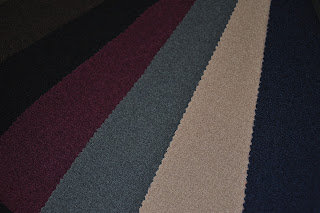Should we do that while painting miniatures up to 90mm, or maybe only bigger? Does it look realistic, or not really?
Sure, when it's done right it looks pretty awesome (for a freehand), shows the skill and dedication of the painter (you know, all these long hours he/she spent painting all the tiny lines). But is it necessary and believable?
Does it add more realism to the mini, or maybe is a bit over the top? I must say I do have my doubts, but still didn't make my mind.
Let's think about it for a moment, and look at some pictures:
Here are some close-ups of contemporary fabrics and photos of clothes made of them.
Silk
Wool
I don't think threads of any of these fabrics would be visible even in scale 1:20. Well maybe except of thickest wools and roughest linen. And of course old and crumpled velvet, but that's completely different thing.
But you may say: it's all contemporary fabrics, made by fancy machines. And what about old times?
Personally I don't really think it was that much different from now. Of course the technology of weaving, and used tools were different, but let's give some credit to our ancestors. Even in the middle ages people were able to weave some fine and delicate fabrics.
Quoting Vikings Online:
"The Vikings were not the barbarians that our Victorian forefathers imagined, so extremely coarsely woven cloth such as sack cloth, is not required for clothing. 10 threads per centimeter was average, whilst 60 threads per centimeter was not uncommon for extremely fine material." Source
Let's do the math:
10 threads per 1 cm, 1mm thick thread, and in scale:
- 1:10 it's 1/10mm thick single thread,
- 1:20 it's 1/20mm thick single thread,
- 1:35 it's 1/35mm thick single thread.
And that's the thick wool... Made by Vikings. How much better should it be on royal courts in more developed parts of the world?
Here are some examples of real medieval fabrics found in archeological excavations.
silk brocade
silk
source
source
wool
source
source
As you can see it's not that primitive and thick as we could imagine.
Looking only from that point of view, all attempts to recreate a fabric on a mini smaller than 1:10 is kinda pointless. Try to imagine how extremely thick would it be when increased to the real size...
Silly, isn't it??:>
But on the other hand....
Textured fabrics, if done properly, and not on every single piece of clothing, definitely add some visual interest to the mini (even if it hurts a little when we think about the 'real' thickness of the painted fabric).
After all, the contrast we build on a mini is way out of proportion to the real life, but it helps to show three-dimensional of the mini.
So maybe textured fabrics, if done with some sense, may be a really nice addition to the mini and not only show off?
I really don't know;p I'll probably try at some point just to prove myself that I can do that good enough. And even said that, I don't think I'd ever dare to 'recreate' threads of silk or other delicate fabrics or on clothes of nobility and kings, but maybe on a woolen cloak it wouldn't be too bad?
And there is one more aspect of this textured affair...
Maybe it's only a temporary trend to paint fabric's threads everywhere it's possible, just to push the border of what's possible in this hobby a little bit further? Maybe it will pass at some point and we'll all get back to the smooth painting?
How do you think?
Am I making mountains out of molehills, or do we have a topic for valid discusion?
cheers
'eM



























niezly pomysl;)
ReplyDeleteSome good thoughts there Marta
ReplyDeleteI may add another if thats ok?
When painting textured fabric what we are painting isn't the actual weave, but the way that light plays on the coarseness of the fabric. And the images you have used in your examples portray it really well. Especially when you look at the difference in the way the silk reflects light versus the wool...
I'm of an opinion that used properly, painted texture can really add to the depth of a model in many scales even down to 30mm. :)
That's exactly the difference here Avicenna:) Some people show different types of fabric by painting the way light reflects from it, and some busily paint 'all' the little lines of threads. I didn't wanted to show any pictures of the minis, because I don't think that's the place, but let's say, good examples here would be the works of Rusto and Yellow One.
ReplyDeletehttps://www.cekaja.com/info/situs-nonton-drama-india/
ReplyDelete